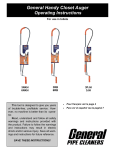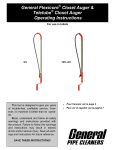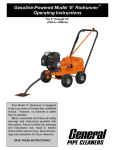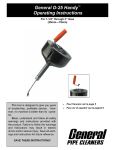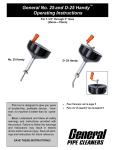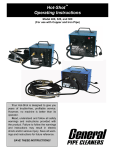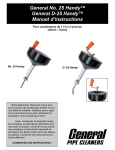Download Cold-Shot Operating Instructions
Transcript
M Cold-Shot™ Operating Instructions For 1/8” through 2” metal and plastic lines (10mm—60mm) Your Cold-Shot is designed to give you years of trouble-free, profitable service. However, no machine is better than its operator. Read, understand and follow all safety warnings and instructions provided with the product. Failure to follow the warnings and instructions may result in electric shock and/or serious injury. Save all warnings and instructions for future reference. SAVE THESE INSTRUCTIONS! Cold-Shot™ GENERAL SAFETY RULES Always wear safety glasses and rubber soled, non-slip shoes. Use of this safety equipment may prevent serious injury. WARNING! Read and understand all instructions. Failure to follow all instructions listed below may result in electric shock, fire and/or serious personal injury. Replacement manuals are available upon request at no charge, or may be downloaded from our website, www.drainbrain.com. Instructional videos are available for download on our website, and may be ordered. If you have any questions or problems, please call General’s customer service department at 412-771-6300. Always wear gloves. Dry ice causes burns if it comes in contact with skin. Do not over tighten freeze heads. Over-tightening increases the possibility of freeze head shattering. SAVE THESE INSTRUCTIONS! Operate in a well ventilated area. Danger of suffocation. Carbon dioxide is heavier than air and can collect at ground level and displace the air if ventilation is inadequate. These instructions are intended to familiarize all personnel with the safe operation and maintenance procedures for the Cold-Shot. This is the safety alert symbol. It is used to alert you to potential personal injury hazards. Obey all safety messages that follow this symbol to avoid possible injury or death. DANGER indicates a hazard with a high level of risk which, if not avoided, will result in death or serious injury. WARINING indicates a hazard with a medium level of risk which, if not avoided, could result in death or serious injury. CAUTION indicates a hazard with a low level of risk which, if not avoided, will result in minor or moderate injury. 2 Cold-Shot™ Work Area 7. Store idle tools out of reach of children and other untrained persons. Tools are dangerous in the hands of untrained users. 1. Keep work area clean and well lit. Cluttered benches and dark areas invite accidents. 8. Maintain tools with care. Replace worn parts as early as possible. 2. Do not operate within two feet of open flame. Heat source within close range of the metal pipe could melt ice plug, causing catastrophic failure and severe water damage 9. Inspect occasionally for any condition that may affect the tool’s operation. If damaged, have the tool serviced before using. Many accidents are caused by poorly maintained tools. 3. Keep bystanders, children, and visitors away while operating. Dry ice causes burns if it comes in contact with skin. 10. Only use parts and accessories that are mended by the manufacturer for your Parts and accessories that may be suitable tool may become hazardous when used on tool. GENERAL SAFETY RULES Personal Safety recommodel. for one another 1. Work only in a well ventilated area. Carbon dioxide is non-toxic and non-flammable, but is heavier than air and can collect at ground level, displacing the air if ventilation is inadequate, giving rise to the danger of suffocation. 11. Only use the Cold-Shot for the purpose for which it was intended. Any unauthorized use or modifications of the Cold-Shot are prohibited for safety reasons. 2. Stay alert, watch what you are doing and use common sense when operating a tool. Do not use tool while tired or under the influence of drugs, alcohol, or medication. A moment of inattention while operating may result in serious personal injury. Service 2. Dress properly. Do not wear loose clothing or jewelry. Contain long hair. Keep your hair, clothing, and gloves away from moving parts. Loose clothes, jewelry, or long hair can be caught in moving parts. 2. When servicing a tool, use only identical replacement parts. Follow instructions in the Maintenance section of this manual. Use of unauthorized parts or failure to follow Maintenance Instructions may create a risk injury. 3. Do not overreach. Keep proper footing and balance at all times. Proper footing and balance enables better control of the tool in unexpected situations. SPECIFIC SAFETY RULES 1. Tool service must be performed only by qualified repair personnel. Service or maintenance performed by unqualified repair personnel could result in injury. 1. Wear eye protection, safety glasses, or goggles. Use of this safety equipment may prevent serious eye injury. 4. Use safety equipment. Always wear eye protection and rubber gloves. Dust mask, non-skid safety shoes, hard hat, or hearing protection must be used for appropriate conditions. 2. Wear rubber gloves. Use of this safety equipment may prevent serious freeze injury from extreme cold. 5. Avoid dangerous flammable liquids or gases. 3. Only use this tool in the application for which it was designed. Follow the instructions on the proper use of the machine. Other uses or modification of the Cold-Shot for other applications may increase risk of injury. 6. Observe all safety instructions provided by the carbon dioxide supply company. Tool Use and Care 4. Never hit a chilled freeze head with a hammer or other tool. A sharp blow will cause the freeze heads to shatter. 1. Only use carbon dioxide (CO 2) cylinders equipped with a dip tube. Carbon dioxide must be drawn from the cylinder in a liquid state in order to produce dry ice. 5. Do not over tighten freeze heads. Gas must be allowed to escape. Over tightening increases the possibility of freeze heads shattering. 2. Do not connect a pressure reducer to the cylinder. 6. Inspect freeze heads for cracks or other signs of wear before each use. Replace at the first sign of deterioration. 3. Keep the cylinder in an upright position and secure it to prevent it from falling over. 4. Do not completely empty the cylinder. 5. Do not interfere with nozzles, freeze heads or valves, including cylinder valves. 6. Use clamps or other practical way to secure and support the work piece to a stable platform. Holding the work by hand or against your body may cause serious personal injury. 3 Cold-Shot™ Note: If only one freeze head is needed, use locking nut to close half of the T-distributor. FEATURES Carrying Case Instruction Manual Rubber Gloves 4. Choose freeze heads which correspond to the size of the pipe to be frozen. 5. Place the freeze heads on the pipe and secure by tightening the knobs evenly, using the hex head wrench provided, to give a firm, but not overly tight, hold. Safety Glasses Freeze Heads 1/8” - 2” “T” Distributor Warning: It is not always necessary for freeze head to clamp completely together. Once freeze head is secured tightly around the pipe, stop tightening. Over tightening can cause stress fractures of freeze head. Injector w/ Spiral Hose (2) Locking Nut Hex Head Wrench DO NOT OVER TIGHTEN THE FREEZE HEADS. THIS CAN PRODUCE STRESS FRACTURES AND CAUSE THE FREEZE HEADS TO SHATTER. HOW THE COLD-SHOT WORKS The Cold-Shot can be used to freeze all types of liquids, even at high pressure, inside steel, copper, cast iron, lead, aluminum and plastic pipe in sizes ranging from 1/8” to 2” (10-60 mm). 6. Push each injector into the bore of the freeze head until it is completely inserted and resting against the stop, then turn clockwise one quarter turn to lock in place. The Cold-Shot uses commercially available carbon dioxide (CO2). You can purchase or rent cylinders through your local welding supply house. Though any size cylinder can be used, it is recommended that users purchase the largest cylinder size possible. NOTE: the CO2 tank must have a dip tube. The dip tube allows liquid rather than gas to flow through the spiral hoses, where it will expand to form dry ice inside the freeze heads. The ice pack which forms in the pipe is capable of withstanding a pressure of approximately 7000 psi (500 bar). As the liquid freezes, a layer of frost will develop on the surface of the pipe. NOTE: The freeze heads must be positioned at least 40” (1 m) apart from each other. SET-UP OPERATION 1. Remove the seal from the carbon dioxide cylinder. 1. The liquid in the pipe can only be frozen when it is no longer flowing. All pumps must therefore be stopped and no liquid allowed to escape from the pipe. Allow water to cool to room temperature before freezing. 2. Screw connector with T-distributor onto cylinder (right -hand thread - clockwise). 3. Screw spiral hoses onto the T-distributor. 2. Fully open the cylinder valve. The amount of carbon dioxide required is controlled automatically. The liquid carbon dioxide expands in the injector and forms dry ice inside the freeze head with a temperature of -110°F (-79°C), and freezes the liquid within the pipe. NOTE: CO2 sputtering from the freeze heads during operation is normal. 4 Cold-Shot™ 5. While work is in progress, the flow of carbon dioxide refrigerant must be maintained. To ensure a sufficient supply of refrigerant is available, a stand-by cylinder is suggested. The only way to determine the amount of remaining carbon dioxide is to weigh the cylinder. If it is necessary to change the cylinder during work, it is essential that this procedure should be completed within 7 minutes to prevent the ice pack from melting. 3. After a brief period, frost will form on the pipe in the vicinity of the freeze heads. (See Table) If frost does not form in accordance with the time given in the table, this indicates that the liquid within the pipe is still flowing or the liquid is too warm. Make sure that all pumps have been switched off and prevent any removal or outflow of liquid. 4. Test to insure you have a complete ice blockage before starting repair. To test, carefully and slightly open a valve or loosen a fitting behind the desired blockage. If leakage of liquid stops after a short while (depending on liquid contents after the ice plug), the blockage is operational. If not, close the valve or tighten the fitting and continue freezing. Or, drill a small hole between the ice plug and repair area. If leakage stops after a short time (as mentioned above), it is safe to proceed. If not, you can use a hose or pipe clamp to stop further leakage, and continue the freezing process. 6. Once work is complete, close the cylinder valve and wait until the pressure in the spiral hoses has returned to normal before removing them from the valve. Once the ice pack has completely melted, carefully unscrew and remove the injector at the end of the spiral hoses from the freeze head, then remove the freeze head from the pipe. ESTIMATED FREEZING TIMES The freezing times and carbon dioxide requirements given in the table below are only to be regarded as general guidelines and are valid for a water temperature of approximately 68°F (20°C). The freezing times and refrigerant consumption values will therefore vary for other temperatures. For freezing liquids in plastic pipes, much longer freezing times are generally required. FREEZE HEAD SIZE 1/8” (10 - 12 mm) 1/4” (15 mm) 3/8” (18 mm) 1/2” (22 mm) 3/4” (28 mm) 1” (35 mm) 1-1/4” (42 mm) 1-1/2” (54 mm) 2” (60 mm) MATERIAL FREEZING TIME CARBON DIOXIDE REQUIREMENT NUMBER OF FREEZING OPERATIONS POSSIBLE PER 20 LBS. (10KG) CYLINDER PER FREEZE HEAD Steel 1 min. 2 oz (60 g) 165 Copper 1 min. 2.25 oz (65 g) 160 Steel 1 min. 2.5 oz (75 g) 130 Copper 2 min. 4.75 oz (135 g) 75 Steel 2 min. 5.25 oz (150 g) 65 Copper 3 min. 7 oz (200 g) 50 Steel 3 min. 8 oz (225 g) 45 Copper 5 min. 11.75 oz (330 g) 30 Steel 5 min. 12.25 oz (350 g) 29 Copper 7 min. 15.75 oz (450 g) 22 Steel 7 min. 17.75 oz (500 g) 20 Copper 10 min. 23 oz (650 g) 15 Steel 11 min. 24.5 oz (700 g) 15 Copper 14 min. 31.75 oz (900 g) 11 Steel 16 min. 37 oz (1050 g) 10 Copper 24 min. 51 oz (1450 g) 7 Steel 29 min. 67 oz (1900 g) 5 5 Cold-Shot™ TROUBLE SHOOTING GUIDE Problem Cause Solution Liquid won’t freeze Liquid still flowing. All liquid flow must be stopped. Pipe not full. Pipe must be full of liquid to create a solid plug when frozen. Incorrect CO2 tank Must use CO2 tank with dip tube. CO2 cannot get to freeze head due to clogged filters. Check and replace clogged filters in the T-Distributor or Injectors. Glycol or antifreeze in pipe. Flush line with water before freezing. Freeze head will not seal tightly. Freeze head is correctly applied. CO2 must escape from freeze head to work properly. Do not over tighten or freeze head could shatter. Freezing time is longer than specified in table. Air temperature, water temperature and type of pipe affect freezing times. Keep spare CO2 tank on hand when freezing larger lines with longer freeze times. Incorrect CO2 tank Must use CO2 tank with dip tube. CO2 flow stopped. Flow of CO2 must be maintained until repair of pipe is complete. Incorrect CO2 tank Must use CO2 tank with dip tube. Pipe does not stay frozen. General Wire Spring Co, 1101 Thompson Avenue McKees Rocks, PA 15136 412-771-6300 www.drainbrain.com © General Wire Spring Co. 2009 C-CSOI-0909






